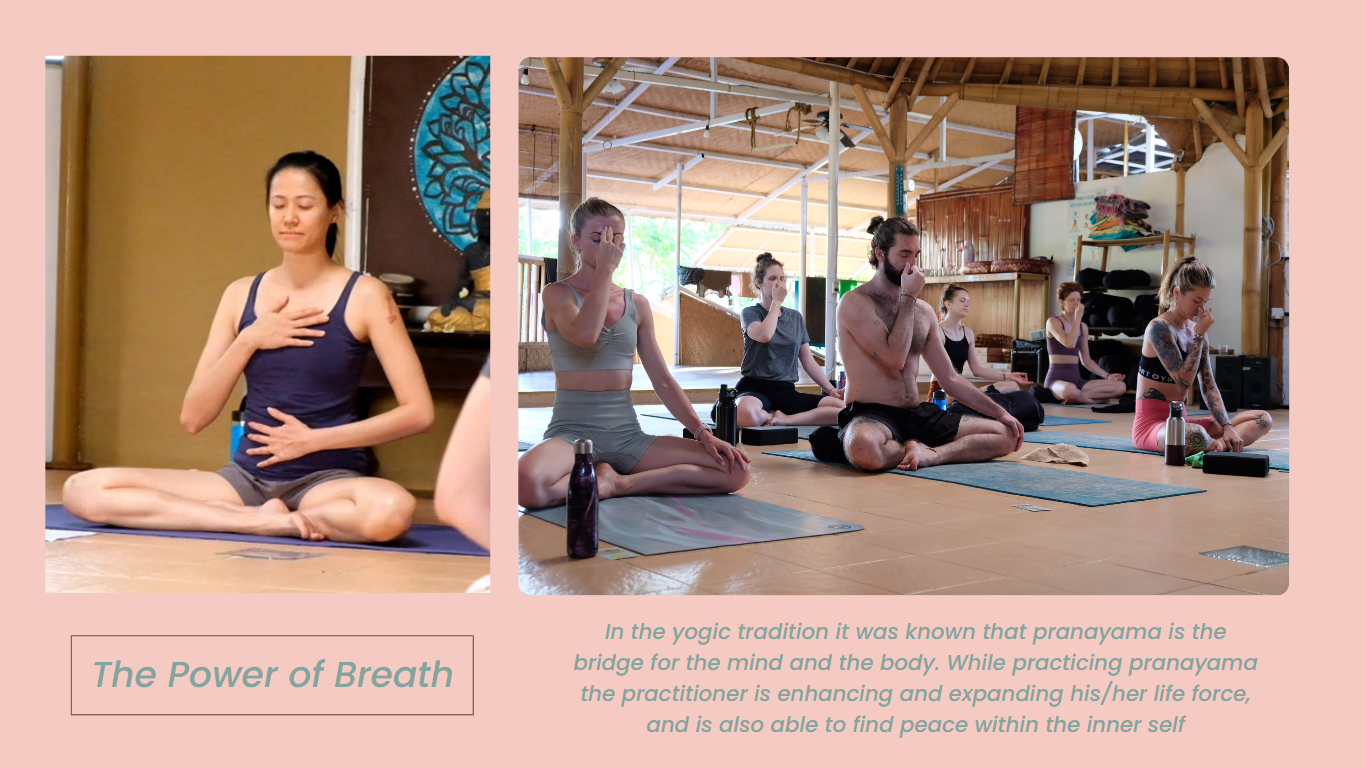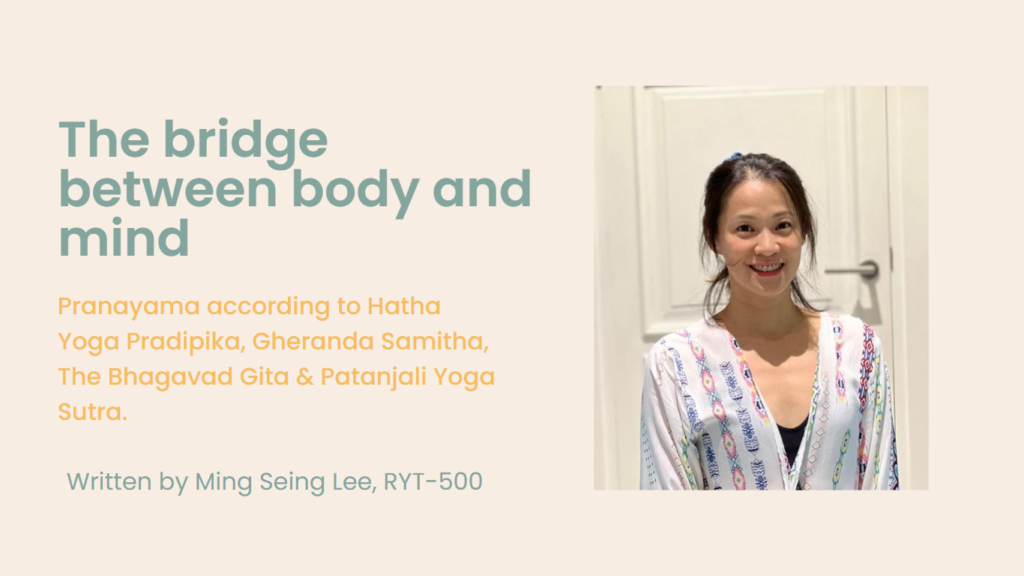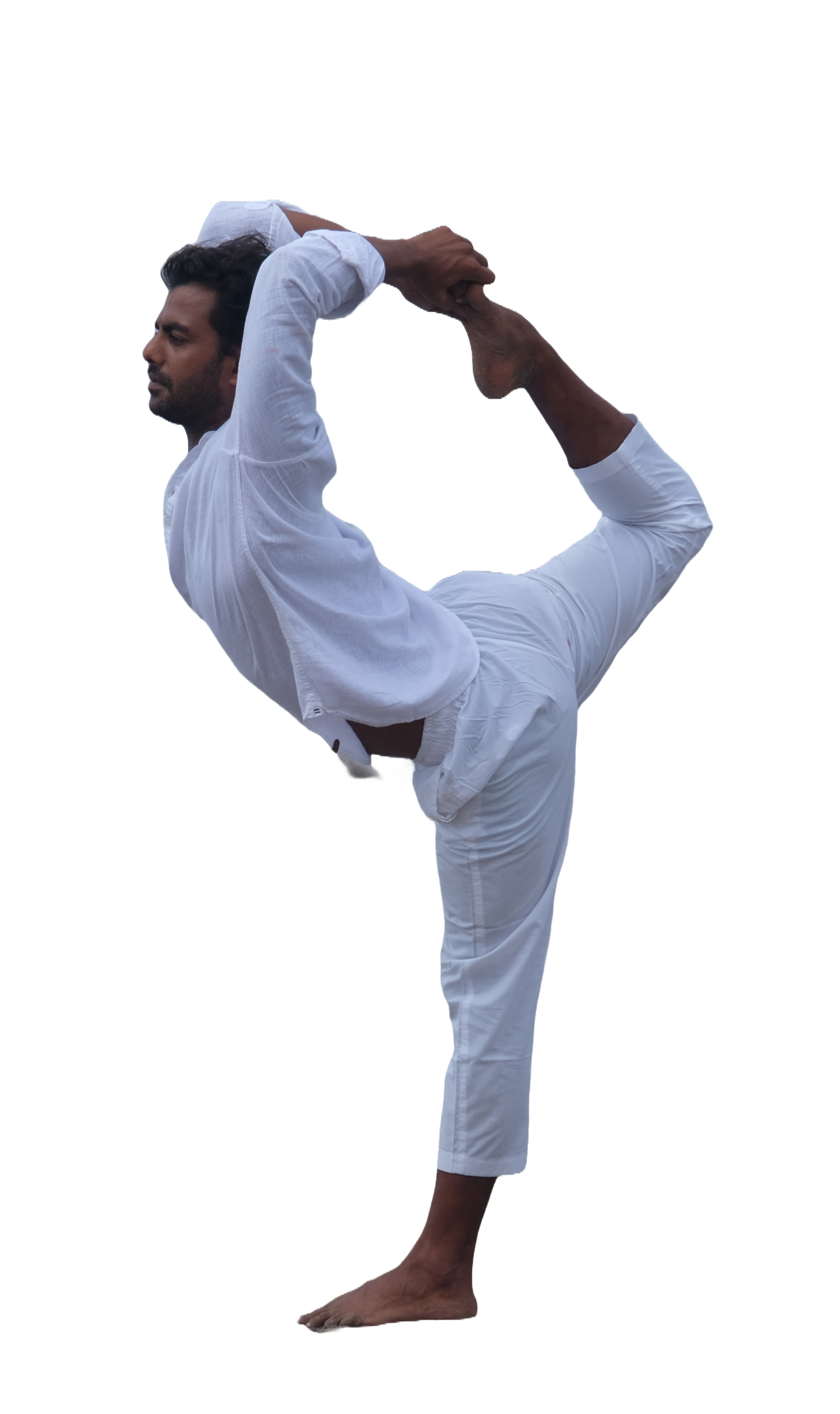Pranayama is a yoga practice to expand the life force or vital energy. Pranayama is often translated as breathing but it is not just breathing. There are 5 layers of kosha on all living things. Annamaya kosha is the food body that is the inner layer of the koshas. Pranamaya kosha, also named as the energy body, lies between annamaya and manomaya (mind body) kosha. While practicing pranayama, we strengthen and purify our pranamaya kosha.
The bridge between body and mind
In the yogic tradition it was known that pranayama is the bridge for the mind and the body. While practicing pranayama the practitioner is enhancing and expanding his/her life force, and is also able to find peace within the inner self. As the pranayama kosha expands, the practitioner can truly meditate.

Pranayama according to Hatha Yoga Pradipika and Gheranda Samitha
The Hatha Yoga Pradipika explained pranayama techniques as kumbakha. Swami Svatmaram introduces eight kumbakha: suryabhedana, ujjayi, sitkari, bhaskari, bhramari, murcha, plavini and kevala. He explains that while doing the pranayama practices, one should lock his/her muladhara.
In the Gheranda Samhita also eight kumbhaka or breath retentions are mentioned: Sahita, Shurya Bheda, Ujjayi, Sheetali, Bhastrika, Bhramari, Murcha, and Kevali.
Most of the pranayama techniques are the same in these two scriptures, such as Suryabhedana, Ujjayi, Sitkari, Bhaskari, Bhramari, Murcha, Sahita and Kevala. The spelling might be different but the techniques explained are similar to each other. Plavini pranayama in Hatha Yoga Pradipika was not found in Gheranda Samhita.
Surya Bheda
Hatha Yoga Pradipika explains Suryabhedana kumbhaka as a technique where you inhale through your right nostril, retain the breath and then exhale through your left nostril. The purpose for it is to increase the temperature of the body and stimulate digestion. If a person continues this practice, it can help cleansing, destroying bacteria in the sinuses. It helps practitioners to activate the pingala nadi. Gheranda Samhita mentioned the same methods as Hatha Yoga Pradipika. Besides its benefits towards the physical body, it further explains the benefits for awakening kundalini and facilitating spiritual growth.
Suryabheda represents the Sun breathing. When there is sun, there is moon. Chandrabheda is the moon breathing technique. Both Sage Gheranda and Swami Svatmaram did not describe it but it is sometimes practiced these days. The only difference to suryabheda is that you inhale through the left nostril which represents the ida nadi, and breath out through the right nostril. It helps practitioners activate their ida nadi. Chandrabheda is recommended for people who are hyperactive as it can calm down the mind. It is not recommended for people who are introvert or people who are already calm.
Ujjayi
Ujjayi kumbhaka is a technique to regulate and extend your breathing with a soft whispering sound from the back of your throat. You inhale through both nostrils and engage your root lock and throat lock to retain your breath. When you need to exhale, you use pranav mudra to close the right nostril and slowly exhale through your left nostril. Continue the practice for a few minutes. It is known to calm the mind and promote relaxation. It is also believed that it can help remove all phlegm related to throat diseases and increase digestive fire.
Ujjayi breath is a breathing technique that is also used in Ashtanga Vinyasa practice. During the asanas practice, the practitioner inhales and exhales through the nose by making a whispering sound by constricting the back of the throat while locking the mula bandha. The technique helps practitioners to remain still and calm in the position and to increase the fire during the asana practice.
Sitkari
Sitkari Kumbhaka is also explained by both Swami Svatmaram and Sage Gheranda, with the variation of Sheetali pranayama. This pranayama technique is known to reduce heat in the body and cools the mind down. It is also beneficial to the digestive system. In Sitkari Kumbhaka you make your lips smile while showing your enclosed teeth, and inhale through your teeth. After that you lock your root and throat lock to retain the breath and then exhale through the nose. Sheetali pranayama, on the other hand, rolls the tongue like a tube and extends it outside of the lips. You inhale through the tongue and while retaining your breath, you lock your root and throat lock. When you want to exhale, you exhale through your nostrils while having your mouth closed.
Bhastrika
Bhastrika Kumbhaka also known as Bellows Pranayama, starts with rapid, forceful inhalations and exhalations for more than 10-20 times. When the practitioner starts to get fatigue, using pranav mudra to close the left nostril, breathe in through the right nostril, retain the breath and lock the root and throat lock for as long as the practitioner can hold. After that, slowly exhale from the left nostril. It is believed to increase the oxygen levels in the body and improves the respiratory, digestive system as well as metabolism.
Bhramari
Bhramari Kumbhaka is known as “humming bee sound” pranayama practice. Bhramari is the sanskits word for bee. This pranayama is name after the humming sound that represents of bees. While practicing Bhramari Khumbhaka, you make the male humming bee sound, which is higher pitch while inhale through your nose, retain your breath and lock mula bandha and jalandhar bandha, and then exhale while making the female humming bee sound which is in a lower pitch. It is known to reduce stress and anxiety and also promote blissfulness to the practitioner.
Murcha
Murcha Kumbhaka, also known as swooning pranayama, is a powerful practice that leads to psychic bliss. It helps practitioners to turn their mind inwards and stop paying attention to the material world. The way to practice this technique is to keep the spine straight, inhale deeply through both nostrils and slowly tilt the head up to 45 degree angle, open both eyes and look towards the center of the forehead where the “third eye” is located. Keep the elbows straight and press the knees with your hands while maintaining shambhavi mudra. Retain the breath as long as the practitioner is comfortable, then exhale slowly through the nose. Come back to the regular sitting position and sit still in sukhasana.
Kevala
Kevala Kumbhaka also known as ajapa japa. It is the spontaneous retention of breath, for example when in deep concentration. With this pranayama practice, the practitioner will do it consciously. Kevala pranayama helps to retain prana in the body, which is the key to longevity. The technique includes inhaling deeply and imaging the breath rising up from the mooladhara, crossing through the anahata chakra, and reaching the nose tip. Hold the breath as long as you are comfortable with, exhale slowly and focus on the breath moving downward from the nose tip through anahata chakra to mooladhara. It is also said that if a practitioner practices this pranayama, it will lead to extreme bliss which is known as manomani.
Sahita
Sage Gheranda explains that Sahita Pranayama will be the first pranayama to practice. Before mastering Sahita Pranayama, one should not practice any other pranayama techniques. Swami Svatmaram also mentioned that one should master Sahita Kumbhaka before practicing Kevala Kumbhaka.
Science of Sahita Pranayama by Sage Gheranda
Sage Gheranda explained there are two divisions in the Sahita Pranayama, Sagarbha and nigarbha. Sagarbha pranayama involves breaking down the AUM Bija mantra while practicing it. While sitting comfortably facing east or north, meditate on red-colored Brahman, inhale through the left nostril with Japa of A Bija Mantra 16 counts, block both nostrils with the Japa of U bija mantra 64 counts, then exhale with the right nostril with Japa of M Bija Mantra 32 counts. Continue the practice with consistency.
Then practice the Nigarbha pranayama. This technique involves mental counting during the practice. Inhale with 4 counts of A Bija mantra, (there will be chanting 4 A mantra in heart) then retain breath with 4 counts of U Bija Mantra (there will be chanting 4 U mantra in heart), exhale with 4 counts of M Bija Mantra (there will be chanting 4 M mantra in heart). Practitioners can start manipulating the ratio of count to fit into inhalation, breath: retention: exhalation = 12: 48: 24. This pranayama technique has numerous benefits for both physical and spiritual bodies enhancing inner growth.
Plavina
Plavina Kumbhaka is the technique where practitioners inhale deeply through both nostrils to fill the air in belly and chest maximally, then retain the breath for a while and slowly release the breath. The benefits for practicing this technique is to increase the digestive fire and improve digestion. With this technique practitioners can float in the water.
How To Practice “So Hum” Meditation? – A step-by-step guide | Read this article
Bhagavad Gita
In The Bhagavad Gita, Krishna explained to Arjuna that the life force or vital energy animates all living beings. He taught that one should control their prana through the practice of pranayama.
Yoga Sutras
In the sadhana pada of Yoga Sutra of Patanjali, mentioned about pranayama in the Asthanga Yoga. Pranayama is the fourth limb of ashtanga yoga. In the sutra 2.49-2.53, Patanjali explaines that after achieving the stillness in a posture, the practice of pranayama begins. The pranayama has three aspects, inhalation, exhalation, and retention of breath. He explaines that the practice has to work together with place, time, and number. While practicing the three aspects of pranayama, the goal is to achieve the breath to become slow and subtle.
Benefits of Pranayama
Pranayama has numerous benefits and a regular practice is key to unlocking its full potential.
1. Stress reduction: Pranayama techniques can help calm the mind and alleviate stress.
2. Increased energy levels: Regular practice of pranayama can enhance vitality and boost overall energy levels.
3. Improved respiratory function: Pranayama exercises strengthen the lungs and enhance lung capacity.
4. Enhanced focus and concentration: Deep breathing techniques in pranayama improve mental clarity and concentration.
5. Better emotional well-being: Pranayama promotes a sense of calmness, emotional balance, and overall well-being.
6. Improved sleep quality: Practicing pranayama before bed can help induce relaxation and improve the quality of sleep.
7. Increased oxygen supply: Pranayama techniques increase the oxygen supply to the body, promoting better overall health.
8. Detoxification: Deep breathing in pranayama aids in the elimination of toxins from the body.
9. Boosted immune system: Regular practice of pranayama can strengthen the immune system and improve resistance to diseases.
10. Enhanced digestion: Certain pranayama exercises can improve digestion and regulate the digestive system.
11. Blood pressure regulation: Pranayama techniques like alternate nostril breathing can help regulate blood pressure.
12. Balancing the nervous system: Pranayama practices help in balancing the autonomic nervous system, promoting relaxation and reducing anxiety.
13. Increased lung capacity: Deep breathing exercises in pranayama expand lung capacity and improve respiratory efficiency.
14. Improved cardiovascular health: Pranayama techniques can promote heart health by improving blood circulation and reducing the risk of cardiovascular diseases.
15. Stress hormone regulation: Pranayama helps regulate the release of stress hormones like cortisol, promoting a sense of calmness and relaxation.
16. Enhanced mindfulness: Deep breathing in pranayama cultivates mindfulness and brings a greater awareness to the present moment.
17. Increased lung efficiency: Pranayama exercises improve the efficiency of oxygen absorption by the lungs, benefiting overall physical performance.
18. Alleviation of anxiety and depression: Pranayama techniques have been shown to reduce symptoms of anxiety and depression.
19. Better control of emotions: Regular practice of pranayama can help individuals gain better control over their emotions and reactions.
20. Spiritual growth: Pranayama is often considered a bridge between the physical and spiritual realms, fostering spiritual growth and self-realization.
This article was written by our student Ming Seing Lee in her 300 h Yoga teacher training in Bali . For Yoga classes you can get in touch with her here.
Popular Courses in Bali
200 hour Yoga Teacher Training in Bali | 300 hour Yoga Teacher Training in Bali | 500 hour Yoga Teacher Training in Bali | 50 Hours Yin Yoga Training in Bali | 50 hours Pranayama Training in Bali | 50 hours Yoga Nidra Training Bali | 50 hours Arm Balancing Training Bali | 100 hour Ashtanga Training Bali
Popular Courses in Germany
200 hour Yoga Teacher Training in Germany | 300 hour Yoga Teacher Training Germany | 50 Hour Yin Yoga Training Germany | 50 Hour Pranayama Training Germany | 50 hour Yoga Nidra Training Germany | 50 Hour Arm Balancing Training | 100 hour Ashtanga Training Germany


